Clinical Reasoning Report: CNA152 Health Assessment, Spring 2024
VerifiedAdded on 2023/01/12
|8
|1657
|73
Report
AI Summary
This report presents a health assessment of a 63-year-old woman named Roseanne who presented with cardiovascular symptoms after a swimming session. The assessment revealed tachycardia, tachypnea, hypertension, and hypothermia. The report details subjective and objective data, including the patient's experience of feeling cold and shivering, alongside vital sign readings. Clinical reasoning is applied to analyze the abnormal vital signs, comparing them to previous readings and considering potential causes such as exercise-induced physiological changes and underlying cardiovascular issues. The pathophysiology of tachycardia, tachypnea, and hypothermia is explained, linking the patient's symptoms to physiological mechanisms. The report also suggests further cues, including investigative tests and assessments, to gain a more comprehensive understanding of the patient's condition, including the potential impact of her recent loss and emotional stress on her health. References are provided to support the analysis.
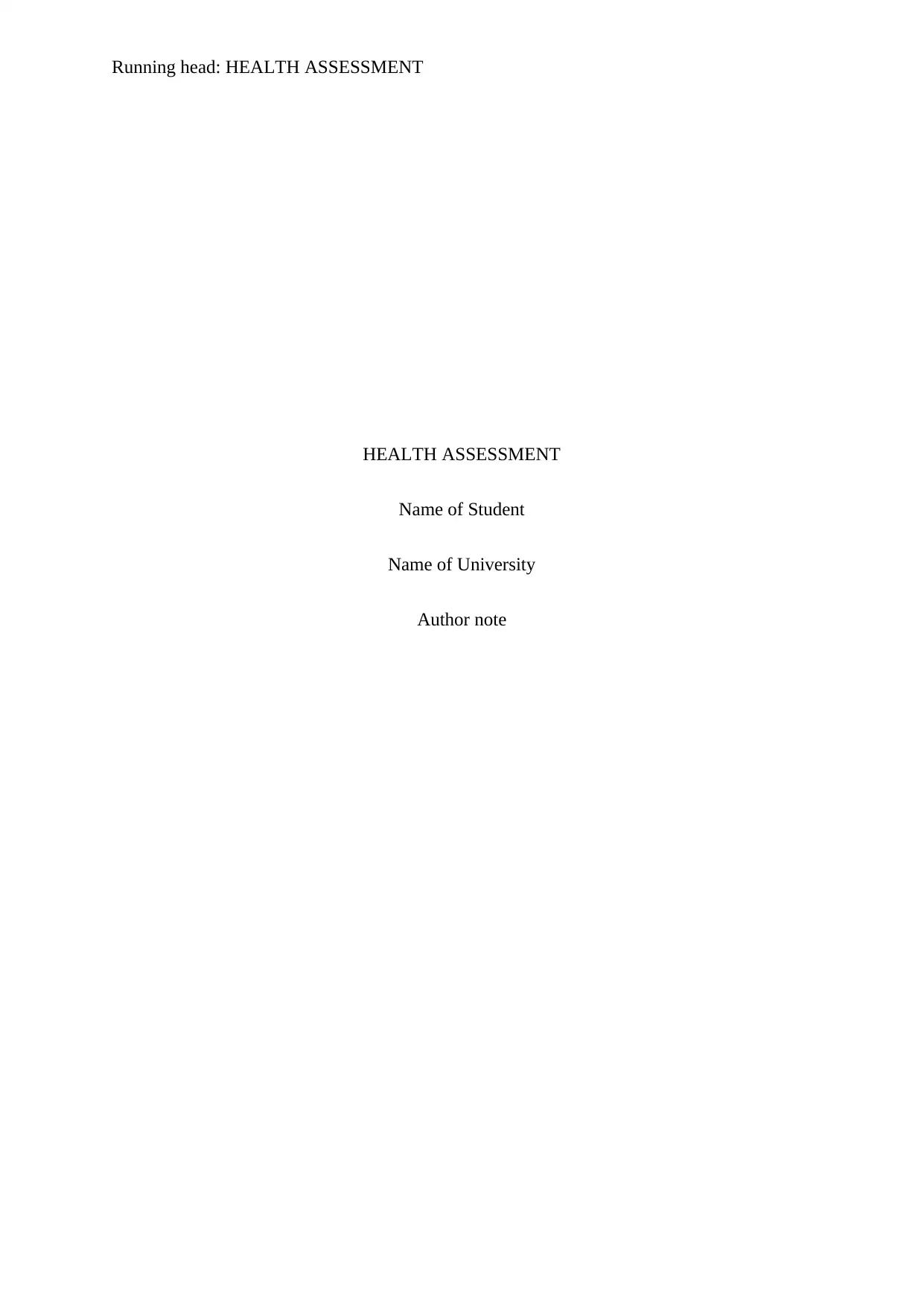
Running head: HEALTH ASSESSMENT
HEALTH ASSESSMENT
Name of Student
Name of University
Author note
HEALTH ASSESSMENT
Name of Student
Name of University
Author note
Paraphrase This Document
Need a fresh take? Get an instant paraphrase of this document with our AI Paraphraser

1HEALTH ASSESSMENT
Table of Contents
1. Introduction.........................................................................................................................2
2. Subjective and objective data.............................................................................................2
3. Clinical reasoning...............................................................................................................2
Pathophysiology of Tachycardia and Tachypnea..................................................................4
Onset of Hypothermia............................................................................................................4
4. Further cues.........................................................................................................................5
References :................................................................................................................................6
Table of Contents
1. Introduction.........................................................................................................................2
2. Subjective and objective data.............................................................................................2
3. Clinical reasoning...............................................................................................................2
Pathophysiology of Tachycardia and Tachypnea..................................................................4
Onset of Hypothermia............................................................................................................4
4. Further cues.........................................................................................................................5
References :................................................................................................................................6
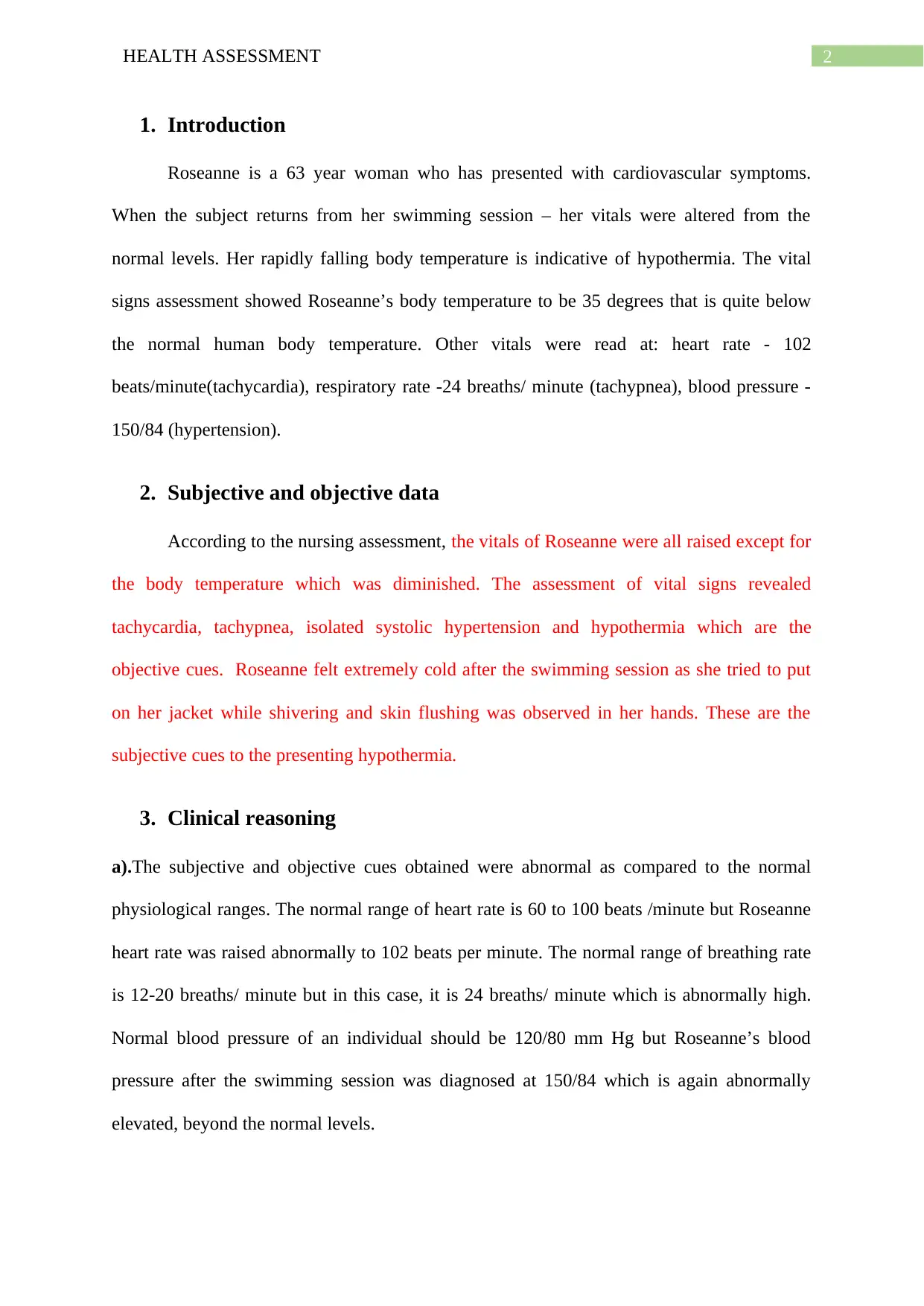
2HEALTH ASSESSMENT
1. Introduction
Roseanne is a 63 year woman who has presented with cardiovascular symptoms.
When the subject returns from her swimming session – her vitals were altered from the
normal levels. Her rapidly falling body temperature is indicative of hypothermia. The vital
signs assessment showed Roseanne’s body temperature to be 35 degrees that is quite below
the normal human body temperature. Other vitals were read at: heart rate - 102
beats/minute(tachycardia), respiratory rate -24 breaths/ minute (tachypnea), blood pressure -
150/84 (hypertension).
2. Subjective and objective data
According to the nursing assessment, the vitals of Roseanne were all raised except for
the body temperature which was diminished. The assessment of vital signs revealed
tachycardia, tachypnea, isolated systolic hypertension and hypothermia which are the
objective cues. Roseanne felt extremely cold after the swimming session as she tried to put
on her jacket while shivering and skin flushing was observed in her hands. These are the
subjective cues to the presenting hypothermia.
3. Clinical reasoning
a).The subjective and objective cues obtained were abnormal as compared to the normal
physiological ranges. The normal range of heart rate is 60 to 100 beats /minute but Roseanne
heart rate was raised abnormally to 102 beats per minute. The normal range of breathing rate
is 12-20 breaths/ minute but in this case, it is 24 breaths/ minute which is abnormally high.
Normal blood pressure of an individual should be 120/80 mm Hg but Roseanne’s blood
pressure after the swimming session was diagnosed at 150/84 which is again abnormally
elevated, beyond the normal levels.
1. Introduction
Roseanne is a 63 year woman who has presented with cardiovascular symptoms.
When the subject returns from her swimming session – her vitals were altered from the
normal levels. Her rapidly falling body temperature is indicative of hypothermia. The vital
signs assessment showed Roseanne’s body temperature to be 35 degrees that is quite below
the normal human body temperature. Other vitals were read at: heart rate - 102
beats/minute(tachycardia), respiratory rate -24 breaths/ minute (tachypnea), blood pressure -
150/84 (hypertension).
2. Subjective and objective data
According to the nursing assessment, the vitals of Roseanne were all raised except for
the body temperature which was diminished. The assessment of vital signs revealed
tachycardia, tachypnea, isolated systolic hypertension and hypothermia which are the
objective cues. Roseanne felt extremely cold after the swimming session as she tried to put
on her jacket while shivering and skin flushing was observed in her hands. These are the
subjective cues to the presenting hypothermia.
3. Clinical reasoning
a).The subjective and objective cues obtained were abnormal as compared to the normal
physiological ranges. The normal range of heart rate is 60 to 100 beats /minute but Roseanne
heart rate was raised abnormally to 102 beats per minute. The normal range of breathing rate
is 12-20 breaths/ minute but in this case, it is 24 breaths/ minute which is abnormally high.
Normal blood pressure of an individual should be 120/80 mm Hg but Roseanne’s blood
pressure after the swimming session was diagnosed at 150/84 which is again abnormally
elevated, beyond the normal levels.
⊘ This is a preview!⊘
Do you want full access?
Subscribe today to unlock all pages.

Trusted by 1+ million students worldwide
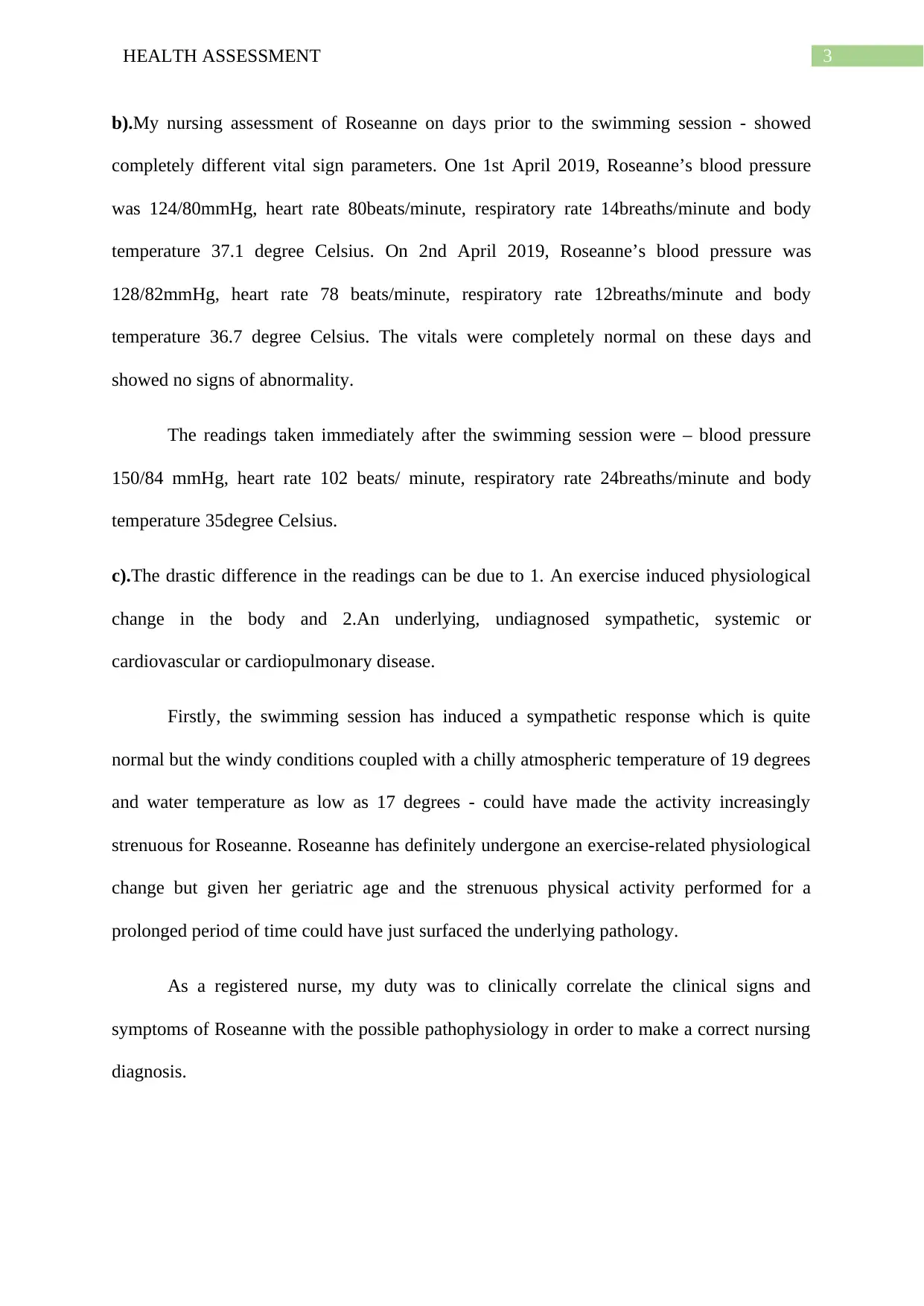
3HEALTH ASSESSMENT
b).My nursing assessment of Roseanne on days prior to the swimming session - showed
completely different vital sign parameters. One 1st April 2019, Roseanne’s blood pressure
was 124/80mmHg, heart rate 80beats/minute, respiratory rate 14breaths/minute and body
temperature 37.1 degree Celsius. On 2nd April 2019, Roseanne’s blood pressure was
128/82mmHg, heart rate 78 beats/minute, respiratory rate 12breaths/minute and body
temperature 36.7 degree Celsius. The vitals were completely normal on these days and
showed no signs of abnormality.
The readings taken immediately after the swimming session were – blood pressure
150/84 mmHg, heart rate 102 beats/ minute, respiratory rate 24breaths/minute and body
temperature 35degree Celsius.
c).The drastic difference in the readings can be due to 1. An exercise induced physiological
change in the body and 2.An underlying, undiagnosed sympathetic, systemic or
cardiovascular or cardiopulmonary disease.
Firstly, the swimming session has induced a sympathetic response which is quite
normal but the windy conditions coupled with a chilly atmospheric temperature of 19 degrees
and water temperature as low as 17 degrees - could have made the activity increasingly
strenuous for Roseanne. Roseanne has definitely undergone an exercise-related physiological
change but given her geriatric age and the strenuous physical activity performed for a
prolonged period of time could have just surfaced the underlying pathology.
As a registered nurse, my duty was to clinically correlate the clinical signs and
symptoms of Roseanne with the possible pathophysiology in order to make a correct nursing
diagnosis.
b).My nursing assessment of Roseanne on days prior to the swimming session - showed
completely different vital sign parameters. One 1st April 2019, Roseanne’s blood pressure
was 124/80mmHg, heart rate 80beats/minute, respiratory rate 14breaths/minute and body
temperature 37.1 degree Celsius. On 2nd April 2019, Roseanne’s blood pressure was
128/82mmHg, heart rate 78 beats/minute, respiratory rate 12breaths/minute and body
temperature 36.7 degree Celsius. The vitals were completely normal on these days and
showed no signs of abnormality.
The readings taken immediately after the swimming session were – blood pressure
150/84 mmHg, heart rate 102 beats/ minute, respiratory rate 24breaths/minute and body
temperature 35degree Celsius.
c).The drastic difference in the readings can be due to 1. An exercise induced physiological
change in the body and 2.An underlying, undiagnosed sympathetic, systemic or
cardiovascular or cardiopulmonary disease.
Firstly, the swimming session has induced a sympathetic response which is quite
normal but the windy conditions coupled with a chilly atmospheric temperature of 19 degrees
and water temperature as low as 17 degrees - could have made the activity increasingly
strenuous for Roseanne. Roseanne has definitely undergone an exercise-related physiological
change but given her geriatric age and the strenuous physical activity performed for a
prolonged period of time could have just surfaced the underlying pathology.
As a registered nurse, my duty was to clinically correlate the clinical signs and
symptoms of Roseanne with the possible pathophysiology in order to make a correct nursing
diagnosis.
Paraphrase This Document
Need a fresh take? Get an instant paraphrase of this document with our AI Paraphraser
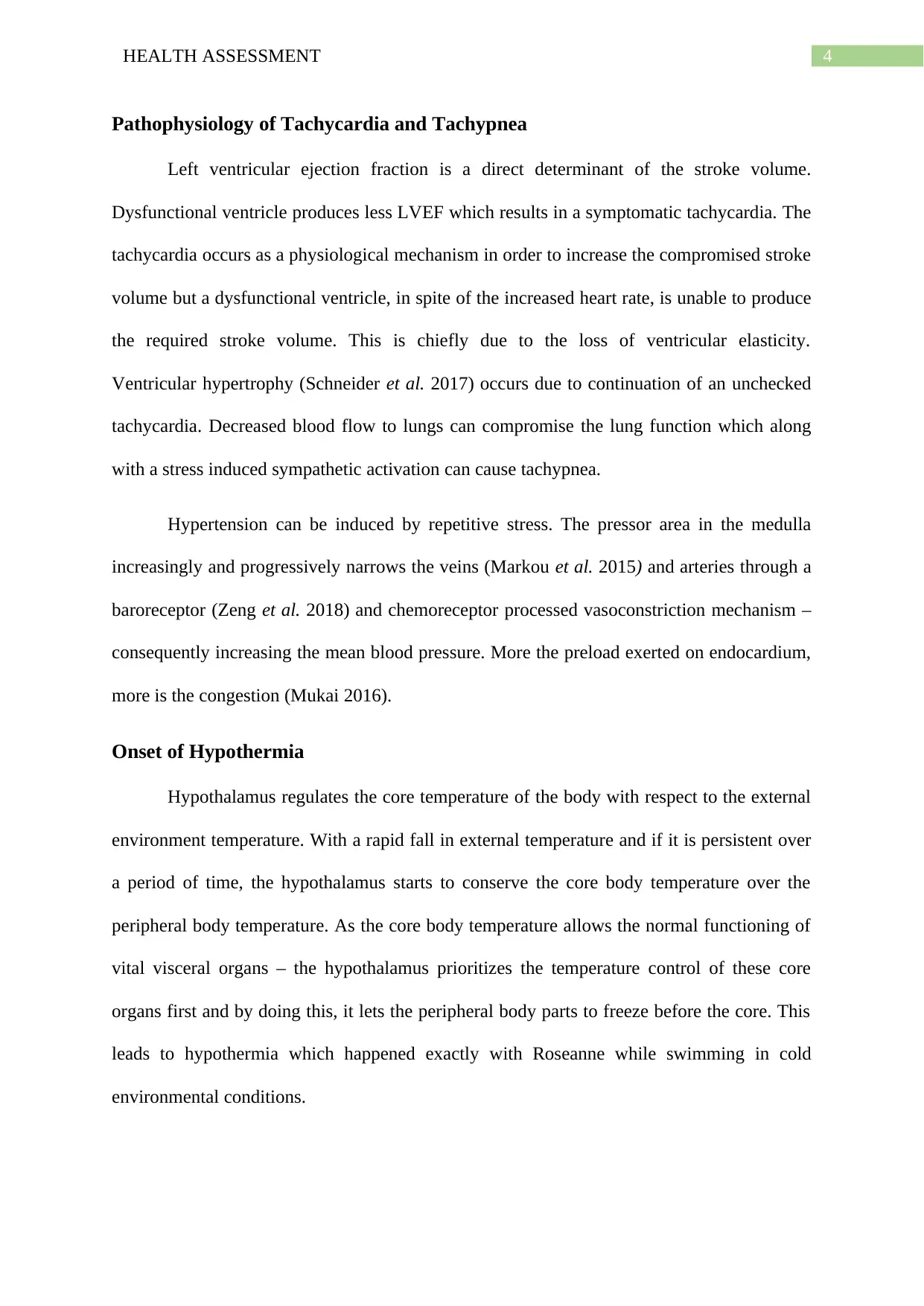
4HEALTH ASSESSMENT
Pathophysiology of Tachycardia and Tachypnea
Left ventricular ejection fraction is a direct determinant of the stroke volume.
Dysfunctional ventricle produces less LVEF which results in a symptomatic tachycardia. The
tachycardia occurs as a physiological mechanism in order to increase the compromised stroke
volume but a dysfunctional ventricle, in spite of the increased heart rate, is unable to produce
the required stroke volume. This is chiefly due to the loss of ventricular elasticity.
Ventricular hypertrophy (Schneider et al. 2017) occurs due to continuation of an unchecked
tachycardia. Decreased blood flow to lungs can compromise the lung function which along
with a stress induced sympathetic activation can cause tachypnea.
Hypertension can be induced by repetitive stress. The pressor area in the medulla
increasingly and progressively narrows the veins (Markou et al. 2015) and arteries through a
baroreceptor (Zeng et al. 2018) and chemoreceptor processed vasoconstriction mechanism –
consequently increasing the mean blood pressure. More the preload exerted on endocardium,
more is the congestion (Mukai 2016).
Onset of Hypothermia
Hypothalamus regulates the core temperature of the body with respect to the external
environment temperature. With a rapid fall in external temperature and if it is persistent over
a period of time, the hypothalamus starts to conserve the core body temperature over the
peripheral body temperature. As the core body temperature allows the normal functioning of
vital visceral organs – the hypothalamus prioritizes the temperature control of these core
organs first and by doing this, it lets the peripheral body parts to freeze before the core. This
leads to hypothermia which happened exactly with Roseanne while swimming in cold
environmental conditions.
Pathophysiology of Tachycardia and Tachypnea
Left ventricular ejection fraction is a direct determinant of the stroke volume.
Dysfunctional ventricle produces less LVEF which results in a symptomatic tachycardia. The
tachycardia occurs as a physiological mechanism in order to increase the compromised stroke
volume but a dysfunctional ventricle, in spite of the increased heart rate, is unable to produce
the required stroke volume. This is chiefly due to the loss of ventricular elasticity.
Ventricular hypertrophy (Schneider et al. 2017) occurs due to continuation of an unchecked
tachycardia. Decreased blood flow to lungs can compromise the lung function which along
with a stress induced sympathetic activation can cause tachypnea.
Hypertension can be induced by repetitive stress. The pressor area in the medulla
increasingly and progressively narrows the veins (Markou et al. 2015) and arteries through a
baroreceptor (Zeng et al. 2018) and chemoreceptor processed vasoconstriction mechanism –
consequently increasing the mean blood pressure. More the preload exerted on endocardium,
more is the congestion (Mukai 2016).
Onset of Hypothermia
Hypothalamus regulates the core temperature of the body with respect to the external
environment temperature. With a rapid fall in external temperature and if it is persistent over
a period of time, the hypothalamus starts to conserve the core body temperature over the
peripheral body temperature. As the core body temperature allows the normal functioning of
vital visceral organs – the hypothalamus prioritizes the temperature control of these core
organs first and by doing this, it lets the peripheral body parts to freeze before the core. This
leads to hypothermia which happened exactly with Roseanne while swimming in cold
environmental conditions.
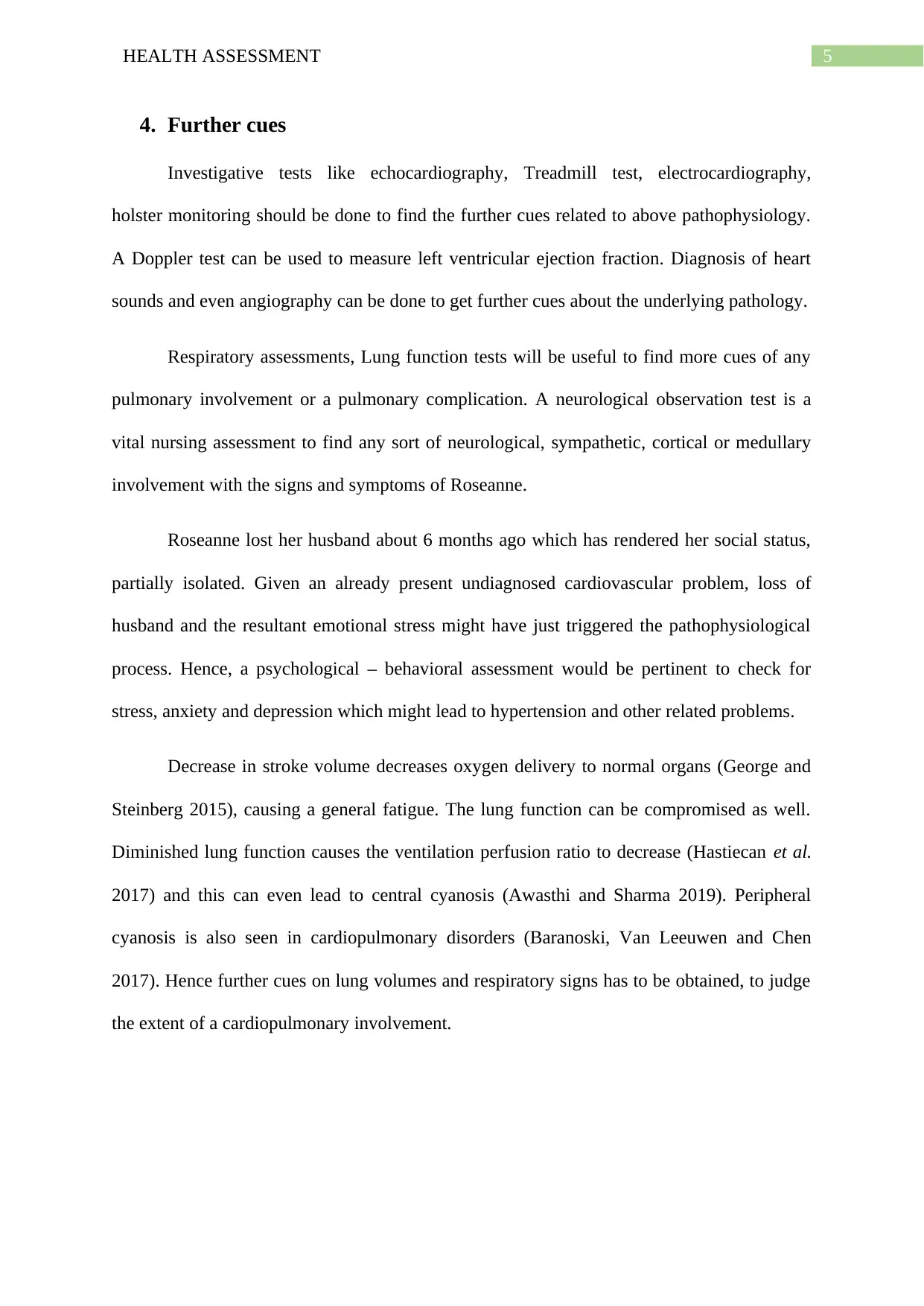
5HEALTH ASSESSMENT
4. Further cues
Investigative tests like echocardiography, Treadmill test, electrocardiography,
holster monitoring should be done to find the further cues related to above pathophysiology.
A Doppler test can be used to measure left ventricular ejection fraction. Diagnosis of heart
sounds and even angiography can be done to get further cues about the underlying pathology.
Respiratory assessments, Lung function tests will be useful to find more cues of any
pulmonary involvement or a pulmonary complication. A neurological observation test is a
vital nursing assessment to find any sort of neurological, sympathetic, cortical or medullary
involvement with the signs and symptoms of Roseanne.
Roseanne lost her husband about 6 months ago which has rendered her social status,
partially isolated. Given an already present undiagnosed cardiovascular problem, loss of
husband and the resultant emotional stress might have just triggered the pathophysiological
process. Hence, a psychological – behavioral assessment would be pertinent to check for
stress, anxiety and depression which might lead to hypertension and other related problems.
Decrease in stroke volume decreases oxygen delivery to normal organs (George and
Steinberg 2015), causing a general fatigue. The lung function can be compromised as well.
Diminished lung function causes the ventilation perfusion ratio to decrease (Hastiecan et al.
2017) and this can even lead to central cyanosis (Awasthi and Sharma 2019). Peripheral
cyanosis is also seen in cardiopulmonary disorders (Baranoski, Van Leeuwen and Chen
2017). Hence further cues on lung volumes and respiratory signs has to be obtained, to judge
the extent of a cardiopulmonary involvement.
4. Further cues
Investigative tests like echocardiography, Treadmill test, electrocardiography,
holster monitoring should be done to find the further cues related to above pathophysiology.
A Doppler test can be used to measure left ventricular ejection fraction. Diagnosis of heart
sounds and even angiography can be done to get further cues about the underlying pathology.
Respiratory assessments, Lung function tests will be useful to find more cues of any
pulmonary involvement or a pulmonary complication. A neurological observation test is a
vital nursing assessment to find any sort of neurological, sympathetic, cortical or medullary
involvement with the signs and symptoms of Roseanne.
Roseanne lost her husband about 6 months ago which has rendered her social status,
partially isolated. Given an already present undiagnosed cardiovascular problem, loss of
husband and the resultant emotional stress might have just triggered the pathophysiological
process. Hence, a psychological – behavioral assessment would be pertinent to check for
stress, anxiety and depression which might lead to hypertension and other related problems.
Decrease in stroke volume decreases oxygen delivery to normal organs (George and
Steinberg 2015), causing a general fatigue. The lung function can be compromised as well.
Diminished lung function causes the ventilation perfusion ratio to decrease (Hastiecan et al.
2017) and this can even lead to central cyanosis (Awasthi and Sharma 2019). Peripheral
cyanosis is also seen in cardiopulmonary disorders (Baranoski, Van Leeuwen and Chen
2017). Hence further cues on lung volumes and respiratory signs has to be obtained, to judge
the extent of a cardiopulmonary involvement.
⊘ This is a preview!⊘
Do you want full access?
Subscribe today to unlock all pages.

Trusted by 1+ million students worldwide
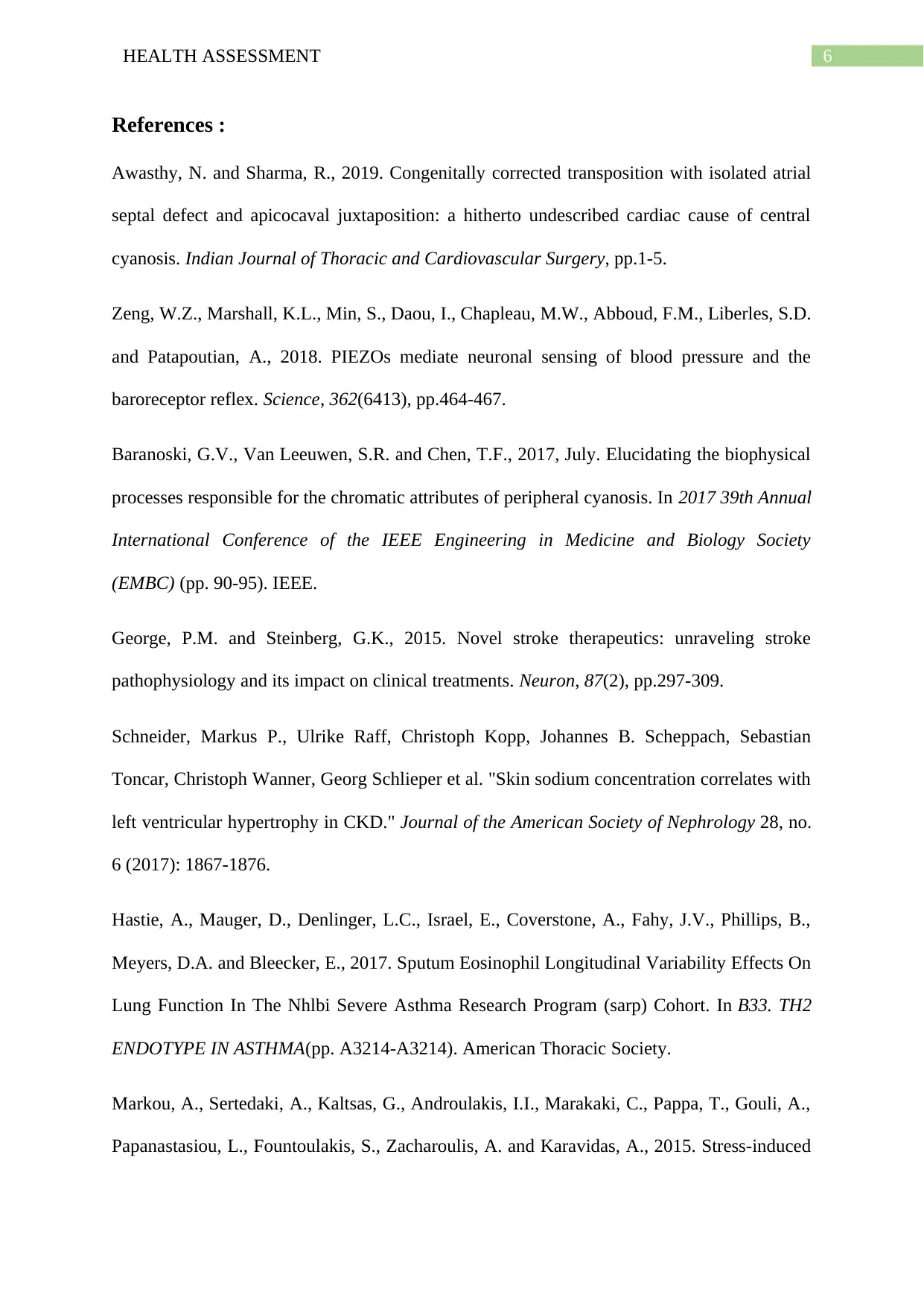
6HEALTH ASSESSMENT
References :
Awasthy, N. and Sharma, R., 2019. Congenitally corrected transposition with isolated atrial
septal defect and apicocaval juxtaposition: a hitherto undescribed cardiac cause of central
cyanosis. Indian Journal of Thoracic and Cardiovascular Surgery, pp.1-5.
Zeng, W.Z., Marshall, K.L., Min, S., Daou, I., Chapleau, M.W., Abboud, F.M., Liberles, S.D.
and Patapoutian, A., 2018. PIEZOs mediate neuronal sensing of blood pressure and the
baroreceptor reflex. Science, 362(6413), pp.464-467.
Baranoski, G.V., Van Leeuwen, S.R. and Chen, T.F., 2017, July. Elucidating the biophysical
processes responsible for the chromatic attributes of peripheral cyanosis. In 2017 39th Annual
International Conference of the IEEE Engineering in Medicine and Biology Society
(EMBC) (pp. 90-95). IEEE.
George, P.M. and Steinberg, G.K., 2015. Novel stroke therapeutics: unraveling stroke
pathophysiology and its impact on clinical treatments. Neuron, 87(2), pp.297-309.
Schneider, Markus P., Ulrike Raff, Christoph Kopp, Johannes B. Scheppach, Sebastian
Toncar, Christoph Wanner, Georg Schlieper et al. "Skin sodium concentration correlates with
left ventricular hypertrophy in CKD." Journal of the American Society of Nephrology 28, no.
6 (2017): 1867-1876.
Hastie, A., Mauger, D., Denlinger, L.C., Israel, E., Coverstone, A., Fahy, J.V., Phillips, B.,
Meyers, D.A. and Bleecker, E., 2017. Sputum Eosinophil Longitudinal Variability Effects On
Lung Function In The Nhlbi Severe Asthma Research Program (sarp) Cohort. In B33. TH2
ENDOTYPE IN ASTHMA(pp. A3214-A3214). American Thoracic Society.
Markou, A., Sertedaki, A., Kaltsas, G., Androulakis, I.I., Marakaki, C., Pappa, T., Gouli, A.,
Papanastasiou, L., Fountoulakis, S., Zacharoulis, A. and Karavidas, A., 2015. Stress-induced
References :
Awasthy, N. and Sharma, R., 2019. Congenitally corrected transposition with isolated atrial
septal defect and apicocaval juxtaposition: a hitherto undescribed cardiac cause of central
cyanosis. Indian Journal of Thoracic and Cardiovascular Surgery, pp.1-5.
Zeng, W.Z., Marshall, K.L., Min, S., Daou, I., Chapleau, M.W., Abboud, F.M., Liberles, S.D.
and Patapoutian, A., 2018. PIEZOs mediate neuronal sensing of blood pressure and the
baroreceptor reflex. Science, 362(6413), pp.464-467.
Baranoski, G.V., Van Leeuwen, S.R. and Chen, T.F., 2017, July. Elucidating the biophysical
processes responsible for the chromatic attributes of peripheral cyanosis. In 2017 39th Annual
International Conference of the IEEE Engineering in Medicine and Biology Society
(EMBC) (pp. 90-95). IEEE.
George, P.M. and Steinberg, G.K., 2015. Novel stroke therapeutics: unraveling stroke
pathophysiology and its impact on clinical treatments. Neuron, 87(2), pp.297-309.
Schneider, Markus P., Ulrike Raff, Christoph Kopp, Johannes B. Scheppach, Sebastian
Toncar, Christoph Wanner, Georg Schlieper et al. "Skin sodium concentration correlates with
left ventricular hypertrophy in CKD." Journal of the American Society of Nephrology 28, no.
6 (2017): 1867-1876.
Hastie, A., Mauger, D., Denlinger, L.C., Israel, E., Coverstone, A., Fahy, J.V., Phillips, B.,
Meyers, D.A. and Bleecker, E., 2017. Sputum Eosinophil Longitudinal Variability Effects On
Lung Function In The Nhlbi Severe Asthma Research Program (sarp) Cohort. In B33. TH2
ENDOTYPE IN ASTHMA(pp. A3214-A3214). American Thoracic Society.
Markou, A., Sertedaki, A., Kaltsas, G., Androulakis, I.I., Marakaki, C., Pappa, T., Gouli, A.,
Papanastasiou, L., Fountoulakis, S., Zacharoulis, A. and Karavidas, A., 2015. Stress-induced
Paraphrase This Document
Need a fresh take? Get an instant paraphrase of this document with our AI Paraphraser
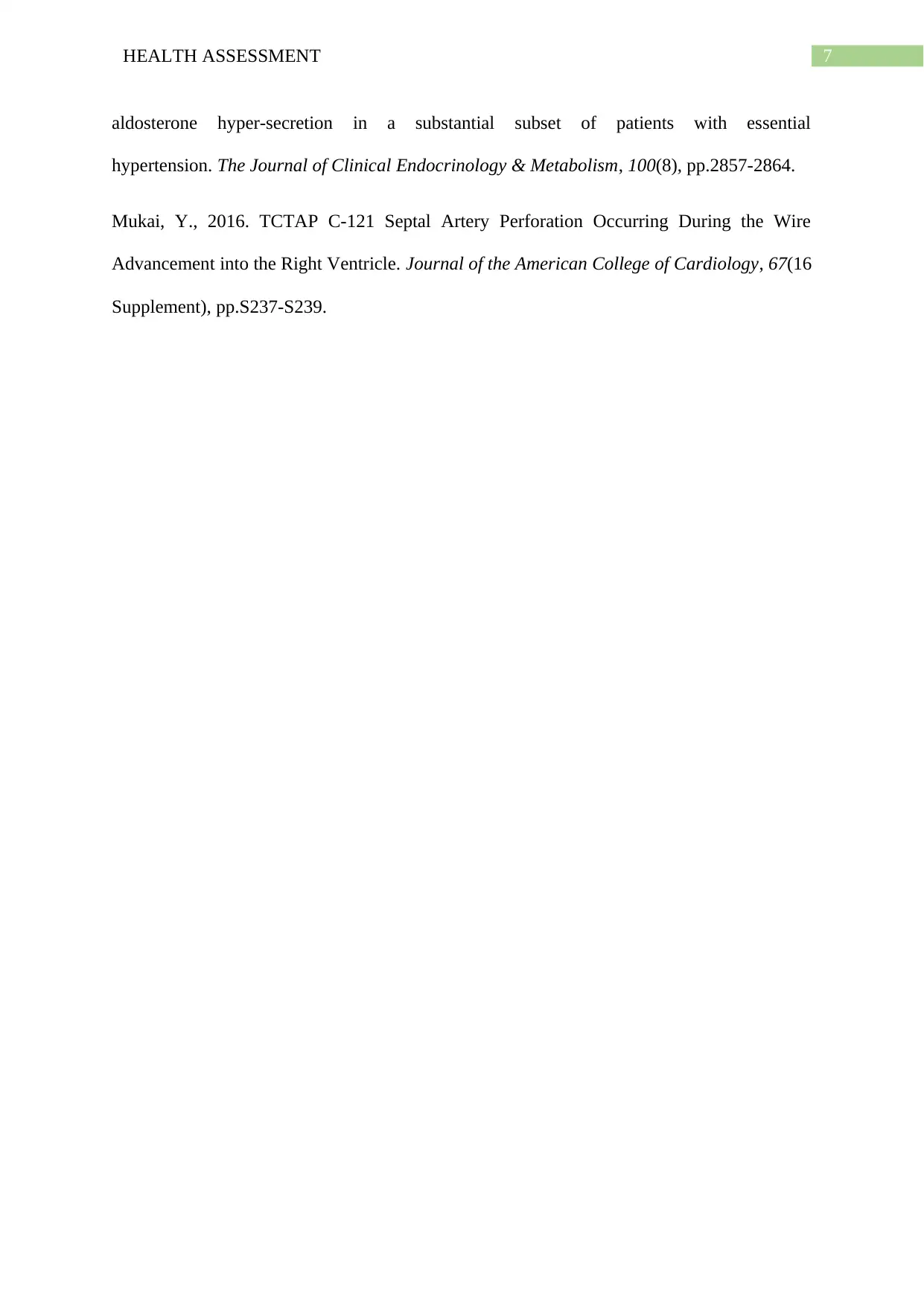
7HEALTH ASSESSMENT
aldosterone hyper-secretion in a substantial subset of patients with essential
hypertension. The Journal of Clinical Endocrinology & Metabolism, 100(8), pp.2857-2864.
Mukai, Y., 2016. TCTAP C-121 Septal Artery Perforation Occurring During the Wire
Advancement into the Right Ventricle. Journal of the American College of Cardiology, 67(16
Supplement), pp.S237-S239.
aldosterone hyper-secretion in a substantial subset of patients with essential
hypertension. The Journal of Clinical Endocrinology & Metabolism, 100(8), pp.2857-2864.
Mukai, Y., 2016. TCTAP C-121 Septal Artery Perforation Occurring During the Wire
Advancement into the Right Ventricle. Journal of the American College of Cardiology, 67(16
Supplement), pp.S237-S239.
1 out of 8
Related Documents
Your All-in-One AI-Powered Toolkit for Academic Success.
+13062052269
info@desklib.com
Available 24*7 on WhatsApp / Email
![[object Object]](/_next/static/media/star-bottom.7253800d.svg)
Unlock your academic potential
Copyright © 2020–2025 A2Z Services. All Rights Reserved. Developed and managed by ZUCOL.





